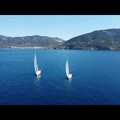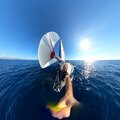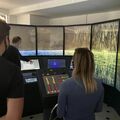Ajánlott írások a MOB témában
2. Yachting oldalon egy nagyon részletes cikk a témában
3. MOB - tactics that really work for couples
4. MOB rescue turn (wikipedia)
5. American Sailing (“Y, T, P, S, C”)
6. A német Yacht magazin írása a MOB témáról
10. Leeward pick up
11. Egy összefoglaló írás arról, hogy leeward vagy windward vegyük-e ki az embert.
A lényeg: Windward Approach
Pros:
- Boat will drift down to the person (better control).
- Less chance of drifting away from the person.
- Blocks wind and waves to create a "calm" for recovery.
- Flotation can be thrown and assisted by wind and waves.
- Easier to launch dinghy or inflatable if necessary for recovery.
- May be a better choice if victim unconscious and unable to assist.
Cons:
- Boat could slam into person in a seaway (rise and fall).
- Boat could push person beneath the boat.
- Requires a fast, efficient recovery system to avoid injury.
Leeward Approach
Pros:
- Sail closer to victim for recovery.
- Protects person from severe injury in seaway.
Cons:
- Must come closer to person for recovery.
- Boat could drift away from person before recovery completed.
- Flotation and rescue equipment must be tossed upwind.
- May require that you make a second attempt if person out of reach.
Man overboard recovery will always be the most dangerous part of the MOB evolution. Just another reason to practice "stay aboard" techniques at all costs. There are specific body motions that will help you stay aboard.
The basics are to grab, look, and go. Do not even think of movement until you have a firm grip on something that will not give way. Look for tripping hazards on deck before you proceed. Then and only then, move your feet. Basic? You bet.
But I believe you would find in most every MOB incident, one of these was forgotten in the moment. We all have forgotten to hold on when changing out a sail. A gust hits, the boat heels, and we slide. Or we may have forgotten to brace ourselves first before we perform a simple task. One way or the other, overboard incidents will continue to happen from time to time.
Each skipper must decide on the final approach to the person in the water based on the "on scene" conditions at his or her location. No weather forecast can predict local conditions. I believe the best preparation will be an intimate knowledge of your own specific boat. Know her bare hull and heave-to characteristics in different wind and sea states. Then you will have the confidence to make the best decision possible in an overboard emergency at sea.
12. Williamson Turn
13. Anderson Turn
14. Scharnov Turn




